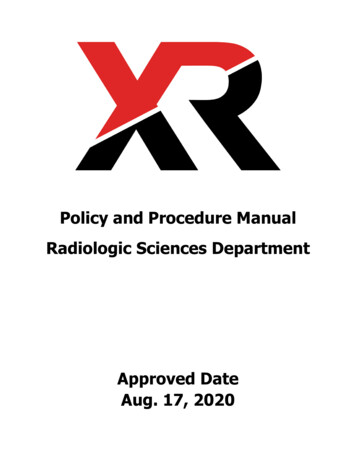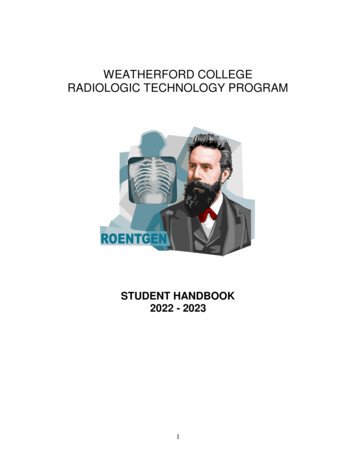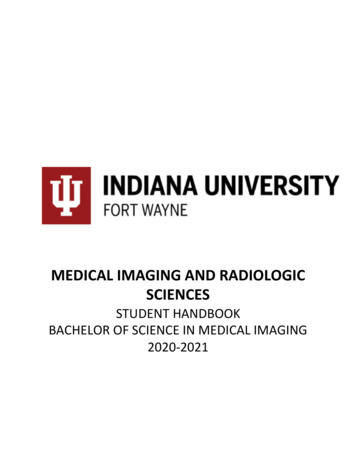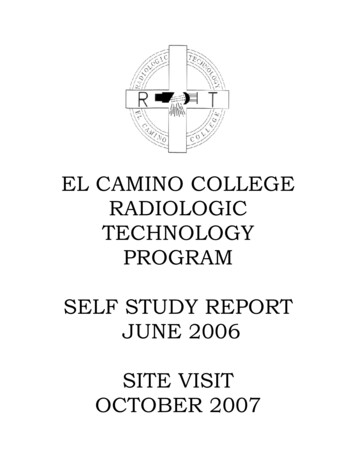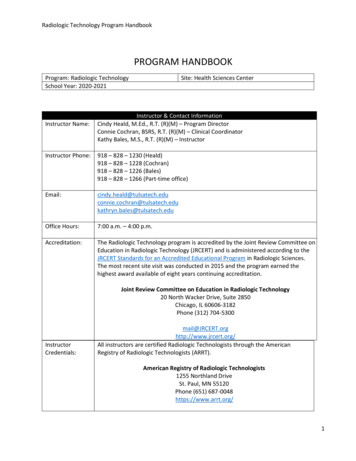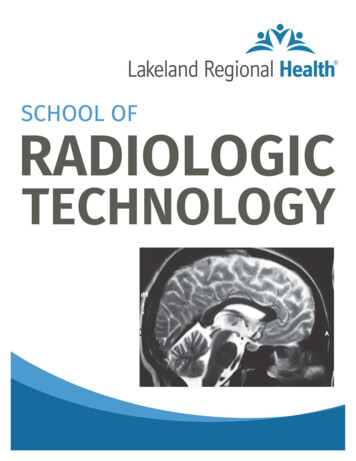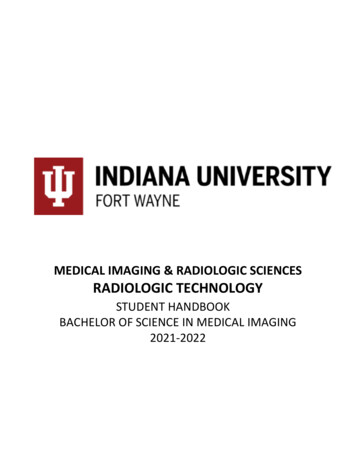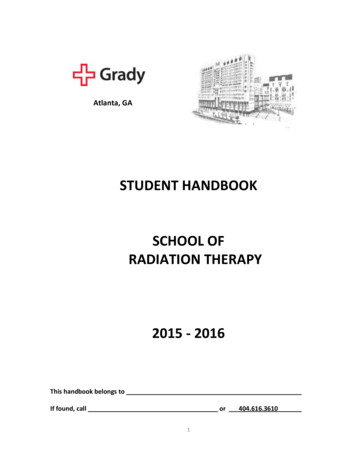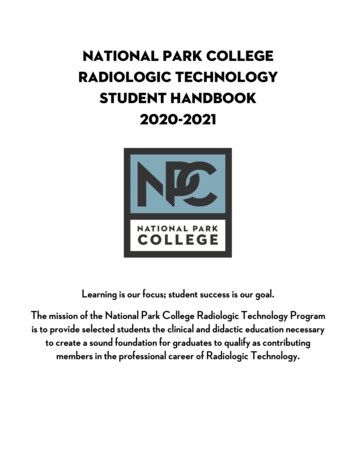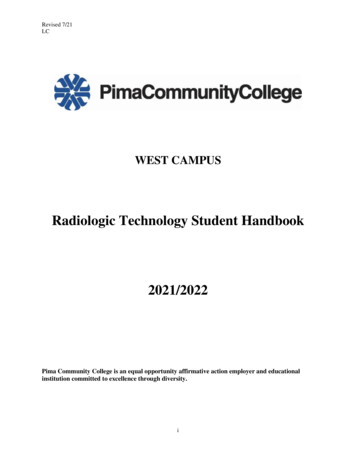
Transcription
Revised 7/21LCWEST CAMPUSRadiologic Technology Student Handbook2021/2022Pima Community College is an equal opportunity affirmative action employer and educationalinstitution committed to excellence through diversity.i
Revised 7/21LCINTRODUCTIONPima Community College (PCC) is accredited by the Commission on Institutions of Higher Education,North Central Association of Colleges and is approved by the Arizona State Board of Directors forCommunity Colleges.The program is accredited by:The Joint Review Committee on Education in Radiologic Technology20 North Wacker Drive, Suite 2850Chicago, Illinois 60606-3182312-704-5300The Radiologic Technology Program embraces the mission and vision statements of Pima CommunityCollege. The Radiologic Technology Program is an integral part of the college and the general policiesformulated for all students who apply to the Radiologic Student Rights and Responsibilities Program.Policies for all Pima College students are found in the PCC Student Handbook, which contains the Codeof Conduct. The radiologic technology student is required to follow the Arizona Department of HealthServices policies and the Division Standard Practice Guide for Students. There are additional policiesspecific to the Radiologic Technology Program. The purpose of this handbook is to communicate thespecific policies of the Pima Community College Radiologic Technology Program.The Pima Community College Radiologic Technology Program reserves the right to make changes asProgram needs require, and to change without notice any information, requirements and regulationspublished in this handbook.Admission to Pima Community College does not automatically guarantee admission to the RadiologicTechnology Program.Student Advising CenterAdvising 206-6699In order to register for any radiography course, a student must be admitted into the program. Graduationfrom the college is not the sole criteria for obtaining qualification to practice Radiologic Technology inthe state of Arizona. Licensing requirements are the exclusive responsibility of the American Registry ofRadiologic Technologists (ARRT) and the Arizona Department of Health Services (ADHS).Radiologic Technology students should expect to spend approximately 40 hours per week in class andclinical activities. Clinical assignment requires considerable preparation. Thus, any additional activities oremployment should be kept at a minimum.ADA StatementPima Community College is committed to providing accommodations for qualified individuals with disabilities in atimely and effective manner. To request a reasonable accommodation, students must be registered with the campusDisabled Student Resources (DSR) office. Accommodations will be made based on eligibility determined byDisabled Student Resources. Services can be requested at any time during the semester. Requesting services well inadvance will help to ensure that resources are available when needed. Please contact a DSR office at 206-6688(West Campus), 206-5151 (Desert Vista) or ADRhelp@pima.edu.ii
Revised 7/21LCTABLE OF CONTENTSRAD Student Handbook can be located 0-2021.pdfINTRODUCTION. iiI.PROGRAM GOALS, LEARNING OUTCOMES, ASSESSMENT PLAN, andCURRICULUMA. Radiologic Technology Program Mission Statement . 1B. Program Goals . 1C. Program Outcomes, Assessment, Curriculum . 2D. RAD Program Technical Standards . 3E. Program Costs and Core Course Information . 6II. COMMUNICATION CHANNELSA. Radiologic Technology Program Offices and Phone Numbers . 8B. Voice Mail . 8III. RULES & CODE OF ETHICS FOR RADIOLOGIC TECHNOLOGIST LICENSUREA. ARRT Standards of Ethics . 8B. ASRT Code of Ethics . 11C. Standards of Professional Code of Ethics . 12IV. ATTENDANCE&TARDINESS/JRCERT&PCC CEC SCHEDULE/EXAMRESTRICTION POLICIESA. Attendance / Tardiness. 13B. JRCERT CEC Schedule Policy Documentation of Utilization of Evening and/orWeekend Assignments . 14C. Advanced Modality Assignments . 14D. Clinical Notebook . 15E. Religious Holidays . 15F. Bereavement Policy . 15G. Chemical Impairment Policy . 15G.5. If the Student Refuses Screening . 16H. Confidentiality . 17I. Positive Drug/Alcohol Screens . 17J. Re-Entry to the Radiologic Technology Program After a Positive Drug/AlcoholScreen . 18K. Negative Drug/Alcohol Screen Being Suspected of Chemical Impairment . 18L. Appeal Statement . 18V. POLICIES/INSURANCEA. General Policies . 19B. Personal Health and Clinical Assignment Requirements Immunization/CPR .19C. Pregnancy Policy . 20D. NRCP Guidelines for Pregnancy . 20iii
Revised 7/21LCE. Infection Control Policy. 20F. Student Health Insurance . 20TABLE OF CONTENTS (continued)VI. CLASSROOM/COLLEGE ASSIGNMENT/CLINICAL ASSIGNMENTA. Methods of Instruction . 21B. Repeat Examinations . 21C. Administration of Pharmacologic Agents: Intravenous and Oral Contrast Media . 21D. Illness/Accidents and/or Injuries in the Clinical Assignment . 22E. Incident Reports . 22F. Supervision & Responsibilities of Students . 23G. Clinical Instructor Position Description. 24H. Duties and Responsibilities . 24I. Qualifications . 25J. Student CEC Notebook Policy. 25K. Student Radiographer Holding Patient / I.R. Policy . 25L. Student Transportation Policy. 25M. Electronic Devices . 26VII. DOSIMETRY BADGE POLICY . 26VIII. UNIFORM POLICYA. Uniforms . 26B. General Appearance . 27IX. TESTING AND GRADING POLICIESA. Testing Policies . 28B. Grading Policy/Re-Entry Policy . 28C. Clinical Assignment Evaluation/Grading . 29D. Official Withdrawal From PCC Statement(s) . 30E. Actions Related to Academic or Laboratory Deficiencies . 30F. Actions Related to Clinical Deficiencies/Conduct. 30X. PIMA COMMUNITY COLLEGE STUDENT SERVICE POLICIESA. Grade Appeals/Complaint Procedure: Academic and Grade Regulations ·················· 32B. Appeal of Academic Disqualification. 33C. Reinstatement . 33D. Grades/Appeals. 33D. Withdrawal From RAD Program . 34XI. RAD PROGRAM MISCELLANEOUS INFORMATIONA. Advanced Standing (Transfer Policy) . 34B. JRCERT Allegations of Non-Compliance Policy . 35C. Student Evaluation of Course, Instructors and Clinical Assignment Sites . 35D. RAD Laboratory Policy . 35E. Protective Devices Maintenance . 36F. Graduation Requirements . 36G. ARRT Examination . 36iv
Revised 7/21LCTABLE OF CONTENTS (continued)APPENDIX A (Course, Instructors, and Facilities Evaluation Sheets)A. Clinical Site Orientation . 38B. Notice of Unsafe or Unacceptable Practice Act . 40C. Radiography Clinical Competency Requirements /PCC Clinical Competency Requirements & Process . 42D. Objectives Check off Forms1. Vital Signs . 472. Sterile and Aseptic Technique . 483. Venipuncture . 494. Transfer of Patients . 505. Care of Patient: Oxygen Therapy . 516. Care of Patient: Catheters & Tubing . 52E. Student Radiographer Clinical Progress Evaluation . 53F. Competency Evaluation Form . 57G. C-Arm Competency Evaluation Form . 59H. Radiographer Image Evaluation RAD 173, 176, 177, 183, 186 . 60I. Radiation Safety Review Form . 62J. Clinical Education Absences Record . 63APPENDIX BA. Scheduling Policy . 65B. Release of All Claims (HRP Form) . 66C. Standard Precautions . 67D. Health Risk Statement of Understanding . 68E. Verification of Personal Health Insurance . 69F. Health Declaration and Physical Exam Form . 70G. Clinical Eligibility Immunization Requirements . 74H. Immunization Declaration Form . 76I. Tuberculosis Document Record & Symptoms Form . 78J. Pregnancy Policy . 80K. JRCERT Allegations of Non-Compliance Policy . 82Direct/Indirect Repeat Examination Policy Verification . 82HIPAA Patient Confidentiality, MRI Safety . 82L. Academic Clinical Warning Form/ Student Deficiency Notice Clinical . 83M. Recommendations for Study ····· 86N. Student Contract Educational Goals ····················· 87O. Clinical Incident Report . 89P. PCC Incident /Accident policy and report form ······· 90Q. Code of Conduct . . 93R. Drug Alcohol Abuse Policy . 94S. J 2 Lab Release of Consent Form . 95T. RAD Program Re-Entry Request Form 96U. Repeat image log form 97V. Signature Form for Radiologic Technology Student Handbook 98W. Student’s Personal Data .99v
Revised 7/21LCI.PROGRAM GOALS, LEARNING OUTCOMES, ASSESSMENT PLAN, andCURRICULUMThe program curriculum is reviewed every two years by the faculty with input from the Advisory ClinicalInstructors Committee members and aligned with the American Registry of Radiologic Technology(ARRT) content specifications. The Program director submits course revisions to the west campuscurriculum specialist, for approval by the College Curriculum Council. The Program director reviews allcourse syllabus content prior to student distribution on My Pima.The Advisory Clinical Instructors Committee members participate in the Student Learning Outcomes(SLO) and assessment plan during the annual fall meeting and documented in the meeting minutes.Additionally, the Program mission, goals and (SLO) are discussed with staff and managers during theregularly scheduled faculty Clinical Education Center (CEC) assignments. The assessment plan isreviewed and discussed at the regularly scheduled faculty meetings.Students are advised of the SLO results and recommendations on a regular basis by the assigned facultyand during the Advisory Clinical Instructors Committee meetings. Program Effectiveness data is locatedon the RAD program web SiteA. RADIOLOGIC TECHNOLOGY PROGRAM MISSION STATEMENTThe Radiologic Technology Program upholds the mission statement of Pima Community College byproviding for the preparation of highly qualified, entry level radiographers. The program will meet theradiologic health needs and expectations of the community through partnerships in clinical education withregional healthcare facilities. The program faculty intends to guide the student in achieving the followingskills, knowledge and values:B.PROGRAM GOALSStudents demonstrate effective communication skills with the patient and health care team.Students demonstrate clinical competency required of an entry- level radiographer.Students demonstrate critical thinking and problem-solving skills that not only involve technicalimaging considerations but also those related to patient needs and clinical restrictions.Students demonstrate professional behavior and values consistent with the rules and code of theAmerican Registry of Radiologic Technologist, and code of ethics of the American Society ofRadiologic Technologists.C.PROGRAM LEARNING OUTCOMESGoal: Students will be clinically competent.Student Learning Outcomes Apply positioning skills, select technical factors, utilize radiation protection,and be competent in the clinical setting.Goal: Students will demonstrate communication skills.Student Learning Outcomes: Demonstrate written and oral communication skills.1
Revised 7/21LCGoal: Students will develop critical thinking skills.Student Learning Outcomes: Critique images to determine diagnostic quality. Adapt standard proceduresfor non-routine patients.Goal: Students will model professionalism.Student Learning Outcomes Student Learning Outcomes: Demonstrate work ethics and the value of lifelong learning.D.Programmatic Assessment Student Learning OutcomesGoal: Students will be clinically competent.Student Learning Outcomes Apply positioning skills, select technical factors, utilize radiationprotection, and be competent in the clinical setting. Critique radiographic images for positioning accuracy. RAD170,171,174,173, 176, 183, 186. Select appropriate technical factors. RAD 170,173, 171,174,175,176, 177,183, 186, 186Goal: Students will demonstrate communication skills.Student Learning Outcomes: Demonstrate written and oral communication skills. Demonstrate written communication competence. RAD 171,174,182. Demonstrate effective oral communication skills. RAD 181, RAD 184, 173,176, 177, 183, 186.Goal: Students will develop critical thinking skills.Student Learning Outcomes: Critique images to determine diagnostic quality. Adapt standardprocedures for non-routine patients. Differentiate factors affecting image quality and image production. RAD172, 175, 182, 173176,177, 183,186. Demonstrate critical thinking and problem-solving skills in the clinical setting.RAD 173,176, 177,183,186.Goal: Students will model professionalism.Student Learning Outcomes Student Learning Outcomes: Demonstrate work ethics and thevalue of life- long learning. Demonstrate professionalism, interpersonal skills and initiative in theclinical setting.RAD 173, 176, 177, 183,186.Summarize professional obligations as a radiographer. RAD 170, RAD 1822
Revised 7/21LCE.RAD PROGRAM TECHNICAL STANDARDSPima Community CollegeAssociate Degree Radiologic Technology ProgramTechnical Standards(Functional Abilities Essential for Radiologic Technology Practice)The purpose of the Radiologic Technology Program is to educate students to meet the program outcomesand to ensure that no graduate will pose a danger to the patient. Radiologic Technology students willreceive both classroom and clinical instruction in entry level radiography and will be required todemonstrate competency in multiple examinations and procedures.In order to provide safe and effective patient care in the Radiologic Technology Program, the studentmust be able to demonstrate, with or without reasonable accommodation, physical, cognitive, andbehavioral abilities required for satisfactory completion of all aspects of the program curriculum andclinical agency requirements. Any applicant who has met the necessary academic prerequisites and can,with or without reasonable accommodation, meet and/or perform the Radiologic Technology ProgramTechnical Standards will be accepted for admission.Students admitted to the Radiologic Technology Program gain experience in many settings that can bephysically demanding, e.g., hospitals, outpatient and urgent care centers, and college labs. During eachclinical experience, the Radiologic Technology student is assigned to a clinical education center that willrequire direct patient care. Students will be expected to adhere to the Health Insurance Portability andAccountability Act (HIPAA) of 1996 which safeguards patient confidentiality.Transportation to and from health care facilities is the responsibility of the student.Please carefully read the Radiologic Technology Program Technical StandardsFunctional AbilityStandardExamples of Required ActivitiesGross motor skills sufficient toprovide the full range of safe andeffective patient care examinations Fine Motor SkillsFine motor skills sufficient toperform manual psychomotorskills Pick up and grasp small objects with fingerssuch as x-ray identification markers.Physical EndurancePhysical stamina sufficient toremain continuously on task for upto a 12- hour clinical shift whilestanding, sitting, moving, lifting,and bending to perform patientcare examinations Walk/stand for extended periods of time; turn,position, and transfer patients.Wear lead aprons, and thyroid collars forextended periods of timeManually resuscitate patients in emergencysituationsGross Motor Skills Move within confined spaces such asexamination room or operating suiteAssist with turning and lifting patientsAdminister CPR3
Revised 7/21LCPhysical StrengthPhysical strength sufficient toperform full range of requiredpatient care activities MobilityFunctional AbilityPhysical ability sufficient to movefrom room to room and maneuverin small spaces; full range ofmotion to twist/bend, stoop/squat,reach above shoulders and belowwaist and move quickly; manualand finger dexterity; and hand-eyecoordination to perform RadiologicTechnology activities StandardPush and pull 250 pounds on wheeled bed orgurneyPush and pull radiographic mobile equipment forextended periods of timeLift and move heavy objects up to 50 poundsMove around in work area and treatment areas.Position oneself in the environment to performduties without obstructing the position of otherteam members or equipmentExamples of Required ActivitiesAuditory ability sufficient forphysical monitoring andassessment of patient health careneeds Normal or corrected visual abilitysufficient for accurate observationand performance of RadiologicTechnology duties TactileTactile ability sufficient forphysical monitoring andassessment of health care needs Feel vibrations (pulses)Detect temperature changesPalpate anatomical landmarks duringradiographic positioningSmellOlfactory ability sufficient todetect significant environmentaland patient odors Detect odors from patient (foul smellingdrainage, alcohol breath)Detect smokeEmotional stability and appropriatebehavior sufficient to assumeresponsibility/accountability foractions HearingVisualEmotional/Behavioral ProfessionalAttitudes andInterpersonal SkillsPresent professional appearanceand demeanor; demonstrate abilityto communicate with patients,supervisors, co-workers to achievea positive and safe workenvironment. Follow instructionsand safety protocols Hear normal speaking level soundsHear auditory alarms (monitors, x-ray exposureindicatorfire alarms, call bells)Hear cries for helpSee objects up to 20 feet awayVisual acuity to set exposure factors and operatecomputer keyboardAssess skin color (cyanosis, pallor)Establish rapport with patients, instructors andcolleagues.Respect and care for persons whose appearance,condition, beliefs and values may be in conflictwith their ownDeliver Radiologic Technology examsregardless of patient’s race, ethnicity, age,gender, religion, sexual orientation or diagnosisConduct themselves in a composed, respectfulmanner in all situations and with all personsWork with teams and workgroupsEstablish and maintain professional boundariesDemonstrate emotional skills to remain calm4
Revised 7/21LCand maintain professional decorum in anemergency/stressful situation Honesty and integrity beyondreproachCommunicationOral communication skillssufficient to communicate inEnglish with accuracy, clarity andefficiency with patients, theirfamilies and other members of thehealth care team, including nonverbal communication, such asinterpretation of facial expressions,affect and body languageDemonstrate prompt and safe completion of allpatient care responsibilities Adapt rapidly to changing environment/stress Exhibit ethical behaviors and exercise goodjudgment Cognitive/QuantitativeAbilitiesReading comprehension skills andmathematical ability sufficient tounderstand written documents inEnglish and solve problemsinvolving measurement,calculation, reasoning, analysis andsynthesis Give verbal directions to or follows verbaldirections from other members of the healthcareteam and participate in health care teamdiscussions of patient careElicit and record information about healthhistory, current health state and responses totreatment from patients or family membersConvey information to patients and others asnecessary to teach, direct individuals in anaccurate, effective and timely mannerRecognize and report critical patient informationto other caregiversCalculate appropriate technical factors givenspecific patient parameters.Analyzes and synthesize data and develop analternative means to obtain the necessaryradiographic images.Collect data, prioritize needs and anticipatereactions.Transfer knowledge from one situation toanotherAccurately process information on medicationcontainer, physicians’ orders, monitors,equipment calibrations, printed documents,medication records, medical records and policyand procedure al abilitysufficient to comprehend threedimensional and spatialrelationships Comprehend spatial relationships in order toproperly perform radiographic exams, assistwith intravenous lines, catheters etc.Clinical ReasoningAbility to reason across time abouta patient’s changing conditionand/or changes in the clinician’sunderstanding Evaluate patient or instrument responses,synthesize data, draw sound conclusionsFlexibilityAdapt to Radiologic TechnologyDepartment course schedulingpolicy Available to work the hours of an assignedschedule.After admission to the Radiologic Technology Program, the student is responsible for notifying theProgram Director and the Clinical Education Center Instructor of conditions that impact the student’s5
Revised 7/21LCability to meet the Radiologic Technology Program Technical Standards. Any change in the student’sability to meet and/or perform the Radiologic Technology Program Technical Standards would requirethe student to provide appropriate documentation (as identified by the Radiologic Technology Program)that they once again meet Technical Standards.If an accommodation is necessary to participate in the Radiologic Technology Program, participation isdependent on the identification of a reasonable accommodation. Reasonableness is determined by theDisabled Student Services (DSR) Office and the Radiologic Technology Program on a case-by-case basisutilizing the Radiologic Technology Program Technical Standards. The accommodation needs to be inplace prior to the start of the program or it may delay your ability to start the program. Pima CommunityCollege provides reasonable accommodations to those students who qualify under the Americans withDisability Act, as amended (ADA). A
The Joint Review Committee on Education in Radiologic Technology 20 North Wacker Drive, Suite 2850 Chicago, Illinois 60606-3182 312-704-5300 The Radiologic Technology Program embraces the mission and vision statements of Pima Community College. The Radiologic Technology Program is an integral part of the college and the general policies
